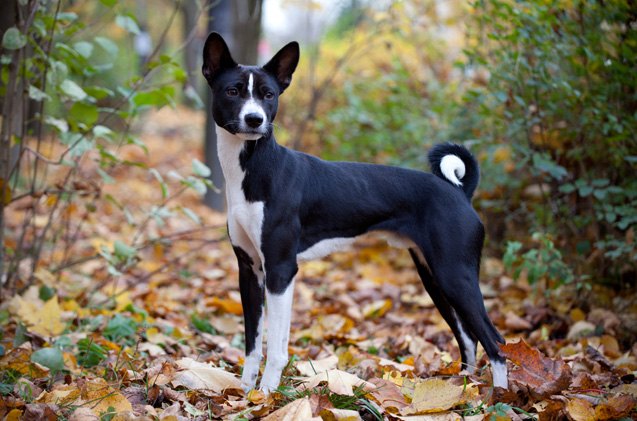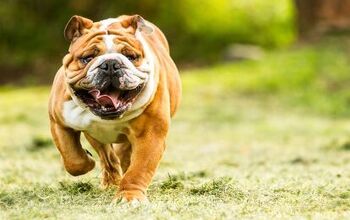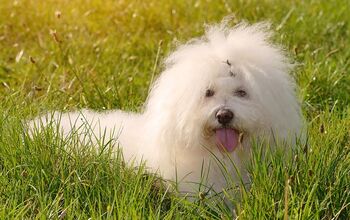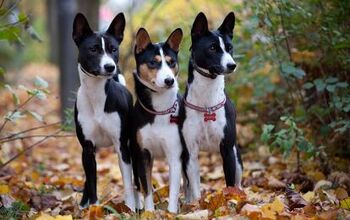Basenji


About Basenji
A small breed boasting a regal look, the Basenji is a unique breed. Known as the barkless dog (it will yodel, howl, and shriek, but never bark), the Basenji belongs in the hound group, but exhibits many terrier-like behaviors, such as being feisty, clever, inquisitive, stubborn, independent, as well as being reserved like a cat
Thanks to its long legs, the Basenji is a good running dog, as it was bred to hunt and run. This breed loves the chase and may take off running to follow its prey. A head-strong dog, the Basenji will eat just about everything, so you’ve got to keep an eye on it. And although it has an independent nature, it’s a part of its personality that takes getting used to. If this breed interests you, read on.
This breed loves the chase and may take off running to follow its prey.
Originating on the continent of Africa, specifically Congo and Zaire, the Basenji was named after the tribes that owned them. This breed was also called Zande dogs or Congo terriers, and native tribes used them for hunting small game. Dogs resembling Basenjis can be seen on the tombs of Egyptian pharaohs, sitting at the feet of its masters.
One of the most ancient breeds, the modern Basenji may be from central Africa, but its ancestor arrived there from eastern Asia, having evolved from either Chinese or southeast Asian wolves.
The Basenji was recognized by the AKC in 1944.
When it comes to feeding your Basenji, go with a dog food with the first listed ingredient being meat. Since Basenjis aren’t fond of dry food, add some raw vegetables on top of its meal or a dab of canned pumpkin for extra fiber.
Basenjis can be trained for a variety of skill sets, thanks to its intelligence and high energy.
Basenjis can be trained for a variety of skill sets, thanks to its intelligence and high energy. Since it is a hunting dog, the Basenji can excel in lure coursing. This consists of a white plastic lure attached to a continuous loop run by a machine that has an operator controlling the speed.
The Basenji can also be trained for competition. Its short coat is easy to upkeep and its regal look goes a long way in the ring.
Obedience training is difficult with this breed, but with hard work and dedication, your dog can be trained. The Basenji strives to please its owner and it has an abundance of energy that needs to be funneled in positive manner. You will find that positive reinforcement, along with firm commands, works best with this breed. As well, you’ll have greater success if you make the dog think that what you want it to do is its idea. If you find training to be too challenging, it may be a good idea to look into hiring a professional.
Male Basenjis weigh 22 to 26 pounds and females weight 20 to 25 pounds.
Basenjis have a range of personalities rolled into one dog. Varying greatly in temperament and attitude, this breed can be described as being alert, loving, assertive and active. You will find that Basenjis adapt best when brought into a family when it is a pup. This breed doesn’t usually get along with other dogs and aren’t good around smaller animals since it will chase and catch them.
The Basenji will become strongly attached to its family. It can be reserved at times and might be uncomfortable with strangers (it will start to circle when it’s not comfortable), as it may feel threatened.
An active dog, the Basenji likes to have fun. This breed needs to get rid of its stored up energy so it won’t act out. If left to its own accord, the Basenji will chew and climb. As well, if it doesn’t get the attention it needs, it will act out… just like a child.
There are a few diseases and disorders the Basenji is prone to, including:
Fanconi Syndrome: An inheritable kidney disorder that shows symptoms after the age of four. Genetic Hemolytic Anemia: A blood disorder.
Basenjis have a life expectancy of 12 to 14 years.
With all the energy, Basenjis need a fair amount of daily exercise. If fact, if this dog had its way, it would run and play all day. Since the Basenji is such a good climber, it should also be kept in a yard with a high, strong fence. Another way to help your dog expend its energy is by signing up for a training class.
Basenjis do not like to be around or in water and will avoid it at all costs, so swimming as a form of exercise is not a viable option.
Varying greatly in temperament and attitude, this breed can be described as being alert, loving, assertive and active.
The American Kennel Club says this about the breed: “A poised, elegant hunting dog from Africa, the Basenji is smoothly muscular and moves with ease and agility. He is lightly built and possesses a wrinkled head and a high, curled tail. The Basenji is commonly known as the “barkless dog,” but when excited, he makes a noise that sounds like a yodel.”
The Basenji has short, silky hair that comes in four different colors – red, black, tan and brindle. The feet, tip of the tail and chest are usually white.
The Basenji is a self-grooming dog, but it is a good idea to brush this dog on a weekly basis, as it loves the added attention and affection.
To ensure that the Basenji bonds with your family, it’s a good idea to bring them into your household as a puppy. Training should start young, especially when it comes to obedience.
Photo credit: Marina Jay/Shutterstock

Amy Tokic, Editor of PetGuide.com, is a passionate animal lover and proud pet parent of Oscar, a Shih Tzu/Chihuahua cross, and Zed, a Japanese Chin. Her love of animals began in kindergarten, when she brought her stuffed dog Snoopy into class with her every day. Now, she writes about her adventures in pet ownership and tirelessly researches products, news and health related issues she can share with other animal enthusiasts. In her free time, Amy loves perusing used book and record stores, obsessing over the latest pet products available and chasing squirrels with wild abandon (a habit attributed to spending too much time with her pooches).
More by Amy Tokic

























